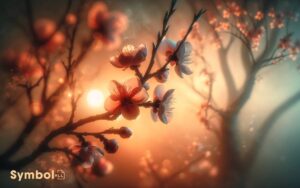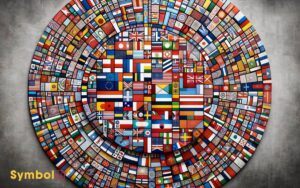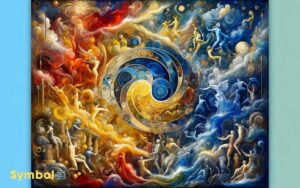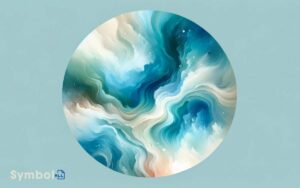What Does the Color Teal Symbolize? Balance and Harmony!
Teal, a blend of blue and green, resonates with balance and harmony. It’s not just a color; it embodies the tranquility of water and the solidity of earth, presenting a sense of calm and clarity.
This unique hue influences your emotions, reducing stress and promoting mental stability. In fashion and design, teal stands for creativity and sophistication, adapting across seasons and spaces.
Culturally, it signifies wealth, healing, and spiritual guidance, carrying varied meanings across the world. Teal’s depth and softness also foster emotional healing and inner peace.
As you explore further, you’ll uncover its profound symbolism across different contexts, revealing its versatility and significance.
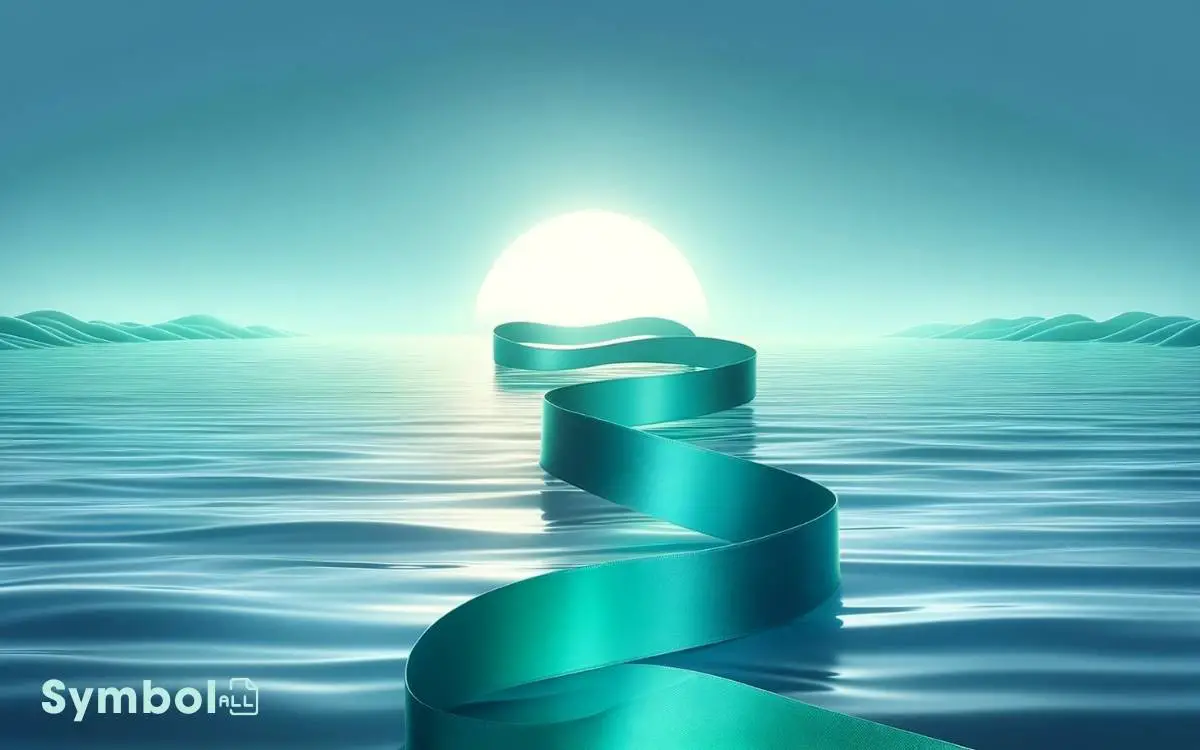
Key Takeaway
The Origin of Teal
The color teal, a sophisticated blend of blue and green, finds its origins in the natural world, embodying a rich history that traces back to both ancient textiles and the serene hues of landscapes and seascapes.
This color’s genesis is deeply rooted in the human endeavor to replicate the vividness of the earth’s palette, suggesting a connection to both the fluidity of water and the stability of the land. This pursuit reflects humanity’s innate desire to bridge the ephemeral with the eternal, capturing the essence of nature’s dual forces in one harmonious shade. Interestingly, the color pink symbolism in the Bible often underscores themes of compassion, love, and divine care, intertwining spiritual interpretations with earthly expressions. Such connections between color and meaning underscore how deeply hues can resonate, transcending mere aesthetics to touch the soul.
Historically, the production of teal pigments involved complex processes, indicative of its value and the lengths to which societies went to harness its beauty.
In examining its origin, you uncover a narrative of innovation, reverence for nature, and the cultural significance that transcends geographical boundaries.
Teal’s journey from the natural world to a symbol in human culture illustrates the interplay between humanity’s creative impulse and the inspiration drawn from the natural environment.
Psychological Effects
Exploring the psychological impacts of teal reveals how it influences one’s emotions and cognition, often instilling a sense of calm and clarity.
This unique color, a blend of blue’s tranquility and green’s optimism, fosters an environment conducive to mental and emotional healing.
It’s no surprise that spaces designed for relaxation and creativity frequently incorporate shades of teal.
The color’s ability to reduce stress levels isn’t merely anecdotal; it’s rooted in color psychology. Teal encourages a balanced mindset, promoting a sense of stability and rejuvenation.
It’s this equilibrium that makes teal particularly effective in therapeutic settings, aiding in the mitigation of anxiety and the enhancement of focus.
Consequently, teal’s impact on the psyche is profound, offering a haven for those seeking serenity and mental clarity.
Teal in Fashion
In the world of fashion, teal commands attention not only for its aesthetic appeal but also for its ability to convey a sense of sophistication and creativity.
This vibrant color bridges the gap between the calming nature of blue and the rejuvenating essence of green, making it a versatile choice for designers and fashion enthusiasts alike. Its presence in fashion signifies a bold, yet balanced, approach to personal expression.
| Aspect | Significance in Fashion |
|---|---|
| Versatility | Suitable for all seasons |
| Sophistication | Elevates everyday attire |
| Creativity | Inspires innovative designs |
| Expression | Allows for personal style statement |
| Balance | Merges boldness with calmness |
Teal’s adaptability guarantees it remains a staple in fashion, adapting to trends while maintaining its timeless charm.
Teal in Design
Shifting focus to design, teal’s versatility extends beyond fashion, offering a rich canvas for creativity and sophistication in various spaces.
- Accent Walls: Teal accent walls can transform a room, infusing it with depth and a sense of tranquility.
- Furniture Pieces: A teal sofa or chair becomes a statement piece, embodying both comfort and style.
- Textiles: Through curtains, rugs, or cushions, teal introduces a layer of warmth and texture.
- Artwork: Teal in artwork adds a splash of color that draws the eye, enhancing the room’s overall aesthetic.
- Kitchen Backsplashes: A teal backsplash can inject vibrancy into kitchens, balancing modernity with classic charm.
In these applications, teal’s unique blend of blue and green shades encourages a balance between calmness and creativity, making it a favored choice in design.
Cultural Interpretations
You’ll find that teal’s meaning shifts dramatically across global cultures, reflecting a rich tapestry of interpretations. Its historical significance varies from symbolizing wealth and status in some societies to representing healing and spiritual guidance in others.
This variance underscores the complexity of cultural symbols, inviting you to explore how colors like teal shape and are shaped by human societies.
Global Perspectives
Exploring the symbolism of teal reveals its diverse interpretations across cultures, reflecting unique historical, spiritual, and social significances.
As you investigate the global perspectives of teal, you’ll find that its symbolism is as varied as the cultures that cherish it.
- In Eastern cultures, teal often symbolizes tranquility and spiritual balance.
- Among Indigenous peoples, it may represent the sacredness of water and earth.
- In Western societies, teal is frequently associated with sophistication and rejuvenation.
- In Middle Eastern regions, it can signify protection and spiritual awakening.
- In Caribbean cultures, teal embodies the vibrant life, energy, and the seamless blend of sea and sky.
Each interpretation offers a window into how colors, like teal, serve as a universal language, yet speak volumes about individual cultural values and beliefs.
Historical Significance
Delving into the historical significance of teal, we uncover its rich tapestry of cultural interpretations, revealing how this color has woven itself into the fabric of various civilizations over time.
In ancient Egypt, teal was a symbol of rebirth, associated with the protective powers of the god Osiris. The Egyptians mined copper minerals, like malachite and azurite, which were ground to produce the pigment.
In Medieval Europe, teal represented piety and was often used in the illuminated manuscripts, signifying a divine connection.
Native American cultures have long regarded teal as a color of healing and spiritual guidance, incorporating it into their art and rituals.
These historical contexts demonstrate teal’s multifaceted symbolism, reflecting the values and beliefs of diverse societies.
Teal and Creativity
You’ll find that teal has a unique position in the domain of color psychology, particularly in relation to creativity.
It’s believed to inspire artistic expression by invoking feelings of calmness and mental clarity, which are conducive to enhancing creative thinking.
This connection suggests that incorporating teal into one’s environment can potentially foster an atmosphere ripe for innovation and imaginative exploration.
Inspiring Artistic Expression
The color teal, with its deep and vibrant hue, often serves as a muse for artists, inspiring creativity and innovation in their work. Its unique blend of blue’s tranquility and green’s essence fosters an environment ripe for artistic exploration and expression.
When you investigate into the essence of teal, you’ll discover it:
- Encourages emotional depth and introspection in art.
- Stimulates a sense of calmness, allowing for focused creativity.
- Serves as a versatile backdrop or accent in various art forms.
- Symbolizes sophistication and a break from traditional color schemes.
- Evokes a sense of mystery and exploration, pushing artists to venture beyond conventional boundaries.
Understanding teal’s influence can enrich your perception of art, revealing layers of meaning and intention that might otherwise go unnoticed.
Enhancing Creative Thinking
In exploring how teal influences creativity, it becomes evident that this color greatly enhances creative thinking by fostering an environment where innovative ideas can flourish.
You’ll find that teal’s unique blend of blue’s calmness and green’s renewal offers a perfect backdrop for deep thought and creativity.
This effect is not just abstract; it’s supported by psychological studies indicating colors can impact mood and cognitive functions.
| Aspect of Creativity | Influence of Teal |
|---|---|
| Emotional State | Induces calmness, making it easier to concentrate and be creative. |
| Environmental Harmony | Blends with natural elements, encouraging open-mindedness and inspiration. |
| Cognitive Stimulation | Stimulates mental agility, promoting innovative thinking and problem-solving. |
Understanding teal’s impact can guide you in creating spaces or choosing attire that enhances creativity, making it a powerful tool in your creative arsenal.
The Calming Nature
Exploring the hue of teal reveals its innate ability to induce a sense of tranquility and calm in individuals, a characteristic deeply rooted in its visual and psychological impact.
This serene effect stems from several key attributes:
- Connection to Nature: Teal embodies the pristine quality of tropical seas and lush landscapes, promoting a natural sense of peace.
- Balance and Harmony: Situated between green and blue, teal symbolizes equilibrium, encouraging mental and emotional stability.
- Depth and Clarity: The depth of teal suggests a profound, contemplative state, fostering clear thought.
- Softness: Unlike more vibrant colors, teal’s softness is less stimulating, easing the mind.
- Cool Temperature: As a cool color, teal inherently has a calming effect, similar to the sensation of being in a shaded, tranquil space.
Understanding teal’s calming nature offers insightful perspectives on its psychological utility and aesthetic appeal.
Teal in Branding
Using teal in branding strategies can greatly enhance a brand’s appeal by leveraging its association with tranquility, reliability, and sophistication.
This color’s unique position between blue and green allows it to evoke a sense of calm and reliability while also implying a level of sophistication and innovation.
This blend of qualities makes teal an excellent choice for brands aiming to stand out in a crowded market.
| Quality | Impact on Branding |
|---|---|
| Tranquility | Soothes customers, fostering trust |
| Reliability | Builds confidence in brand quality |
| Sophistication | Elevates brand perception |
| Innovation | Differentiates from competitors |
| Market Standout | Attracts attention in crowded spaces |
Spiritual Meaning
Beyond its influence in branding, teal also harbors profound spiritual significance, offering a window into the soul’s deepest needs for harmony and renewal.
This mesmerizing hue serves as a bridge between the emotional serenity of blue and the rejuvenating energy of green, embodying a unique balance that resonates deeply with the human spirit.
Its spiritual implications are vast, inviting you to explore:
- Teal’s association with emotional healing and inner peace.
- Its role in promoting mental clarity and thoughtfulness.
- The color’s connection to creativity and inspiration.
- Teal as a symbol of trustworthiness and reliability in spiritual contexts.
- Its significance in fostering a sense of universality and interconnectedness.
Analyzing teal through a spiritual lens reveals its potential to profoundly affect one’s inner journey, encouraging a state of calm introspection and growth.
Teal and Healing
Teal’s profound association with healing processes offers an intriguing avenue for examining its impact on both physical and emotional well-being.
This color, a blend of the calming blue and the rejuvenating green, inherently carries qualities that are conducive to healing environments.
You’ll find its presence in healthcare settings isn’t just for aesthetic appeal; rather, it’s deeply rooted in the psychological effects it has on patients.
Studies suggest that teal can notably reduce stress levels, promoting a sense of peace and tranquility.
Additionally, its connection to clarity and creativity aids in emotional healing by encouraging self-expression and emotional release.
Analyzing the role of teal in therapeutic contexts reveals its potential to foster an atmosphere where healing isn’t just a possibility, but a natural progression.
Teal in Nature
In the vast tapestry of the natural world, the color teal emerges as a vivid thread, weaving through landscapes and life forms in a display of beauty and ecological significance.
You’ll find teal’s presence isn’t just for essential pleasure; it serves vital roles in nature, from camouflage to signaling.
- Tropical Seas: Teal colors the shallow waters where sunlight dances, supporting diverse marine life.
- Bird Plumage: Certain bird species, like the teal duck, boast vivid teal feathers, pivotal for mating displays and camouflage.
- Insects: Dragonflies and butterflies often display teal hues, aiding in species recognition.
- Vegetation: Some plants exhibit teal in their leaves or flowers, a unique adaptation to their environments.
- Gemstones: Minerals such as turquoise bear teal, connecting the earth’s geology with its surface beauty.
This color’s occurrence in nature underscores its importance in ecological systems and evolutionary strategies.
Color Combinations
When paired with complementary or contrasting hues, teal reveals a spectrum of visual harmony and dynamic design possibilities. Its versatility allows it to enhance or subdue elements within a palette, depending on its application and the colors it’s combined with.
When teal intersects with warm colors like coral or orange, it evokes an energizing and invigorating effect, highlighting its capability to invigorate a space or design.
Conversely, alongside cooler tones such as grey or navy, it introduces depth and sophistication, underscoring its adaptability.
This duality underscores the importance of understanding color relationships and the effects they elicit.
Teal’s interaction with other colors not only affects aesthetic appeal but also influences the psychological and emotional ambiance of a space, demonstrating its profound impact within visual communication.
Future of Teal
As we venture into the future, the role of teal in design and visual culture is poised to evolve, reflecting broader trends in sustainability and digital innovation.
Here’s how teal’s journey is expected to unfold:
- Teal will likely become a symbol for eco-friendly initiatives, echoing the global push for environmental conservation.
- In digital platforms, its calming effect will be harnessed to create immersive, soothing user experiences.
- Teal’s adaptability will see it pairing with innovative materials in fashion and interiors, signaling both luxury and mindfulness.
- As a color of technological progress, it may dominate branding for cutting-edge companies.
- Its psychological implications of balance and rejuvenation will be increasingly leveraged in spaces promoting mental health and wellbeing.
These trends highlight teal’s dynamic future as it intersects with societal shifts towards sustainability, mental health, and digital engagement.
Conclusion
In wrapping up, consider teal, the color that whispers of balance and renewal. Much like the Phoenix rising from its ashes, teal embodies regeneration, a proof of its healing powers and serene presence in our lives.
With its footing in both the calming blue and the rejuvenating green, teal isn’t just a color; it’s a symbol of harmony and growth.
As we’ve dissected its impact across various domains, it’s clear teal isn’t merely a trend but a timeless beacon of tranquility and insight.

